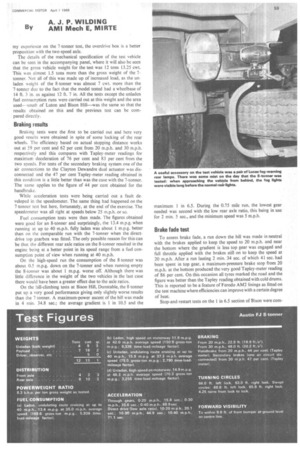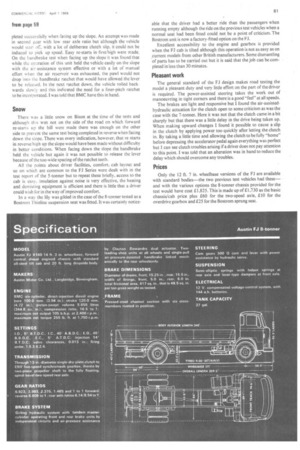A. J. P. WILDING By AMI Mech E, MIRTE
Page 61

Page 63

If you've noticed an error in this article please click here to report it so we can fix it.
my experience on the 7-tonner test, the overdrive box is a better proposition with the two-speed axle.
The details of the mechanical specification of the test vehicle can be seen in the accompanying panel, where it will also be seen that the gross vehicle weight for the test was 12 tons 13.25 cwt. This was almost 1.5 tons more than the gross weight of the 7tonner. Not all of this was made up of increased load, as the unladen weight of the 8-tonner was almost 7 cwt. more than the '7-tonner due to the fact that the model tested had a wheelbase of 14 ft. 3 in. as against 12 ft. 7 in. All the tests except the unladen fuel consumption runs were carried out at this weight and the area used-south of Luton and Bison Hill-was the same so that the results obtained on this and the previous test can be compared directly.
-Braking results
Braking tests were the .first to be carried out and here very good results were obtained in spite of some locking of the rear wheels. The efficiency based on actual stopping distance works out at 59 per cent and 62 per cent from 20 m.p.h. and 30 m.p.h. respectively and this compares with Tapley-meter readings for maximum deceleration of 76 per cent and 83 per cent from the two speeds. For tests of the secondary braking system one of the air connections to the Clayton Dewandre dual actuator was disconnected and the 47 per cent Tapley-meter reading obtained in this condition is a little better than was the case with the 7-tonner. The same applies to the figure of 44 per cent obtained for the handbrake.
While acceleration tests were being carried out a fault developed in the speedometer. The same thing had happened on the 7-tonner test but here, fortunately, at the end of the exercise. The speedometer was all right at speeds below 25 m.p.h. or so.
Fuel consumption tests were then made. The figures obtained were good for an 8-tonner and surprisingly, the 13.4 m.p.g. when running at up to 40 m.p.h. fully laden was about 1 m.p.g. better than on the comparable run with the 7-tonner when the directdrive top gearbox was fitted. The only possible reason for this can be that the different rear axle ratios on the 8-tonner resulted in the engine being at a better point in its speed range from a fuel consumption point of view when running at 40 m.p.h.
On the high-speed run the consumption of the 8-tonner was about 0.5 m.p.g. down on the 7-tonner and when running empty the 8-tonner was about 1 m.p.g. worse off. Although there was little difference in the weight of the two vehicles in the last case there would have been a greater effect due to the axle ratios,
On the hill-climbing tests at Bison Hill, Dunstable, the 8-tonner put up a very good performance giving only slightly worse results than the 7-tonner. A maximum-power ascent of the hill was made in 4 min. 34.8 sec.; the average gradient is 1 in 10.5 and the
maximum 1 in 6.5. During the 0.75 mile run, the lowest gear needed was second with the low rear axle ratio, this being in use for 2 min. 5 sec., and the minimum speed was 5 m.p.h.
Brake fade test
To assess brake fade, a run down the hill was made in neutral with the brakes applied to keep the speed to 20 m.p.h. and near the bottom where the gradient is less top gear was engaged and full throttle applied with the brakes still on to keep the speed at 20 m.p.h. After a run lasting 2 min. 34 sec. of which 41 sec. had been spent in top gear, a maximum-pressure brake stop from 20 m.p.h. at the bottom produced the very good Tapley-meter reading of 86 per cent. On this occasion all tyres marked the road and the figure was better than the Tapley reading obtained with cold drums. This is reported to be a feature of Ferodo AM2 linings as fitted on the test machine where efficiencies can improve with a certain degree of heat.
Stop-and-restart tests on the 1 in 6.5 section of Bison were corn
pleted successfully when facing up the slope. An attempt was made in second gear with low rear axle ratio but although the vehicle would start off. with a lot of deliberate clutch slip, it could not be induced to pick up speed. Easy re-starts in first/high were made. On the handbrake test when facing up the slope it was found that while the operation of this unit held the vehicle easily on the slope with the air-assistance system effective or with a lot of manual effort when the air reservoir was exhausted, the pawl would not drop into the handbrake ratchet that would have allowed the lever to be released. In the next ratchet down, the vehicle rolled backwards slowly and this indicated the need for a finer-pitch ratchet to be incorporated. I was told that BMC have this in hand.
Snow There was a little snow on Bison at the time of the tests and although this was not on the side of the road on which forward re-starts up the hill were made there was enough on the other side to prevent the same test being completed in reverse when facing down the slope. There was every indication, however, that re-starts in reverse/high up the slope would have been made without difficulty in better conditions. When facing down the slope the handbrake held the vehicle but again it was not possible to release the lever because of the too-wide spacing of the ratchet teeth.
All the points about driver facilities, comfort, cab layout and so on which arc common to the FJ Series were dealt with in the test report of the 5-tanner but to repeat these briefly, access to the cab is easy, insulation against noise is very effective, the heating and demisting equipment is efficient and there is little that a driver could wish for in the way of improved comfort.
In a way the lily was gilded in the case of the 8-tanner tested as a Bostrom Thiniine suspension seat was fitted. It was certainly notice
able that the driver had a better ride than the passengers when running empty although the ride on the previous test vehicles when a normal seat had been fitted could not be a point of criticism. The Bostrom unit is now a factory-fitted option on the FJ.
Excellent accessibility to the engine and gearbox is provided when the FJ cab is tilted although this operation is not as easy as on ,current models from other British manufacturers. Some dismantling of parts has to be carried out but it is said that the job can be completed in less than 30 minutes.
Pleasant work
The general standard of the FJ design makes road testing the model a pleasant duty and very little effort on the part of the driver is required. The power-assisted steering takes the work out of manoeuvring in tight corners and there is a good "feel" at all speeds.
The brakes are light and responsive but I found the air-assistedhydraulic actuation for the clutch open to some criticism as was the case with the 7-tonner. Here it was not that the clutch came in a bit sharply but that there was a little delay in the drive being taken up. When making upward changes I found it possible to cause a slip in the clutch by applying power too quickly after letting the clutch in. By taking a little time and allowing the clutch to be fully "home" before depressing the accelerator pedal again everything was perfect but I can see clutch troubles arising if a driver does not pay attention to this point. I was told that an alteration was in hand to reduce the delay which should overcome any troubles.
Prices
Only the 12 ft. 7 in. wheelbase versions of the FJ are available with standard bodies—the two previous test vehicles had these— and with the various options the 8-tanner chassis provided for the test would have cost £1,825. This is made up of £1,730 as the basic chassis/cab price plus £60 for the two-speed axle, £10 for the overdrive gearbox and £25 for the Bostrom sprung seat.




















































































































